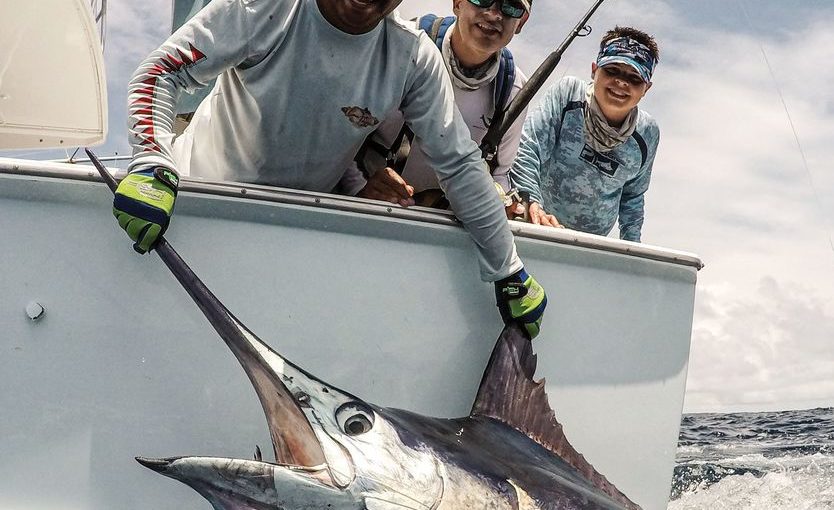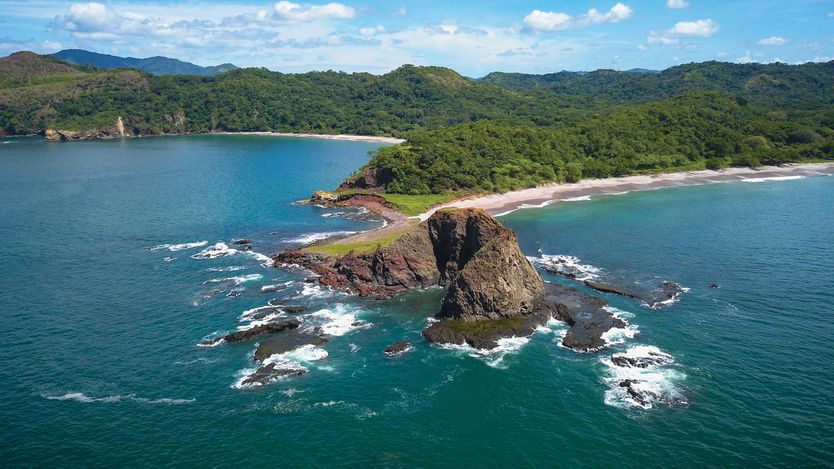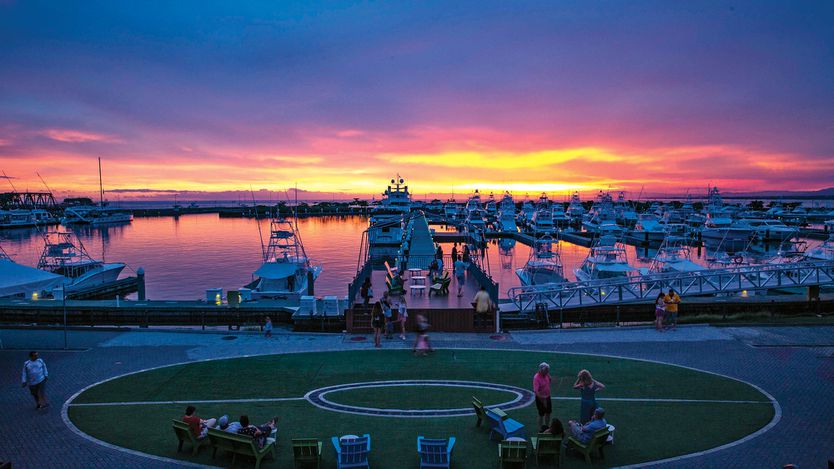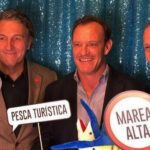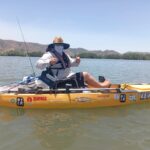A complete guide to catching billfish in Costa Rica
What to expect, who to charter, when to go.
By Todd Staley, published for Sport Fishing Magazine
Not until the early 1990s did sailfishing off Costa Rica’s Pacific coast attract major international attention, and by the turn of the century, Costa Rica was billing itself as the “sailfish capital of the world.” Just after that, however, sailfish numbers began to take a major hit, and many anglers ended up more disappointed than excited. But thanks to the adoption of regulations limiting the commercial exploitation of sailfish about 10 years ago, as described in more detail on page 60, sailfish populations have rebounded and remain strong enough to justify the country’s self-anointed title. For example, consider the one-day total from 43 boats during the second leg of the Los Sueños Triple Crown in 2016, when 1,103 sailfish were caught and released.

But there’s more to Costa Rica’s billfish story than sailfish alone. Marlin were, of course, always here and part of the action, but until recent years, Costa Rica wasn’t really known as a marlin destination. That has changed as well, in part thanks to the overnight trips to seamounts and FADs (fish-aggregating devices) far offshore, trips a number of charters now offer. When boats start raising close to 30 marlin in a day, the international billfishing community takes notice.
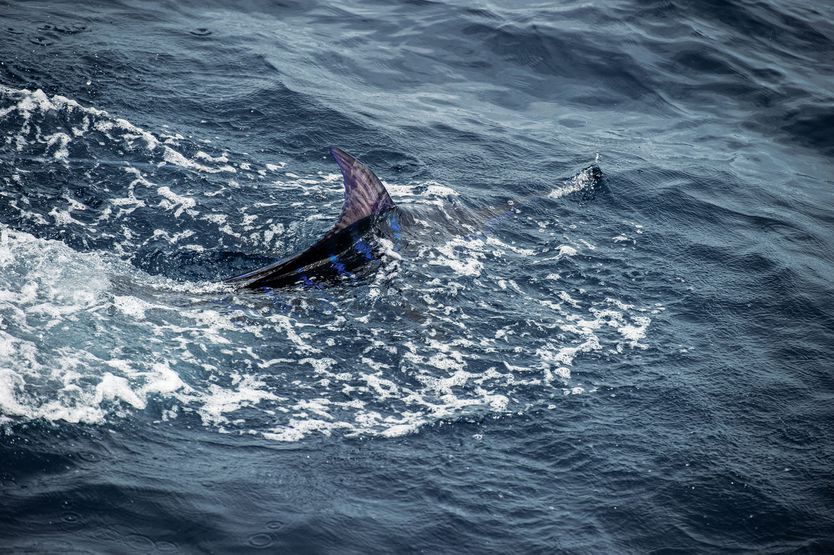
Marlin off the coast of Costa Rica
Marlin were always available off Costa Rica, but sailfish were the main target. In part, the focus on FADs far offshore has changed that, with world-class marlin action in the offing.Will Drost
This is not to suggest that catching 30 marlin or dozens of sailfish in a day is a foregone conclusion off Costa Rica’s Pacific coast. But are such days possible? Absolutely.
Costa Rica is fortunate to have two billfish seasons: The fishing peaks from November through April in the central and southern regions and from May through December in the north. There are fishing clubs such as the Club Amateur de Pesca and the National Fishing Club that have been around for decades, but tourists traveling to Costa Rica is relatively new.
Billfishing in Costa Rica
Wherever you fish for billfish in the world, the approach is a little different; each location has its own style. Costa Rica is no exception.
Most charter captains here troll a combination of teasers, lures and natural baits, including bonito and ballyhoo.
Costa Rican Pacific Coast
The entire Costa Rican Pacific coast offers gorgeous vistas of unspoiled jungles, beaches and headlands such as Playa Mina, shown here, south of Flamingo.Stefan Neumann
No matter where along the country’s Pacific coast you look to charter a sport-fisher, keep in mind that communication is key to any good charter-fishing trip, and that should start before you step on the boat. Many wholesalers and captains rely on repeat business, so they want to be sure your trip provides more than a boat ride.
If all the info you need isn’t on an operation’s website, feel free to call and ask about such things as fishing hours, type of equipment, if fishing licenses are provided, if the crew are women- and child-friendly, and the level of English spoken on board.
Once you arrive for a chartered day and step on the boat, have a conversation with the captain and crew before you leave the dock. Be honest about your level of experience as far as fishing for billfish is concerned, and remember, there are no stupid questions—particularly if billfishing is a whole new ballgame for you. Most crews will be happy to give you as much or as little help as you want.
When a fish appears in the spread, often the captain on a tower boat is the first to see it, and will start shouting the position of the fish behind the boat to crew and anglers on deck. In these first crazed minutes, the captain’s adrenalin might have him frantically blurting this out in Spanish for the crew, using words that mean: short, long, left and right, depending on which teaser the fish came up.
Six words that can help during the melee of hooking up are often shouted out in Spanish:
marlin = marlín (mar-LEEN)
sailfish = pez vela (pays BAY-la)
left = izquierda (ees-KYEHR-dah)
right = derecha (deh-REH-chah)
long = largo
short = corto
Though most crews speak at least some English, it might not hurt to learn a few simple phrases in Spanish before traveling to Costa Rica because that is the native tongue. Long before you arrive at the coast, you will have probably already learned “Pura vida!” which is a Costa Rican greeting that basically means “Everything is great.” “Cerveza fría” will get you a cold beer. Crews love to teach and love to hear about the fishing you do back home, so don’t be shy. Their world is much smaller than yours. Share it.
Many Costa Rica charters practice bait-and-switch fishing, a particularly exciting method for catching billfish that requires a well-coordinated effort, with the captain keeping track of where the fish is, the mate keeping the fish interested, and the angler presenting the bait at the right moment. With luck, the sail or marlin is interested, but you need to wait for it to eat, turn and start to move away, while feeding it line. The use of circle hooks is required in Costa Rica when using natural baits, so calmly place the reel in gear and just start winding.
If you understand everyone’s role in the process, you have a much better chance of hooking up the first fish in the spread rather than learning from your error.
A fishing license, which is required by law, can be purchased online at the website of the fisheries agency INCOPESCA (incopesca.go.cr) before your trip. A permit good for up to eight days is $15. The agency allows sport fishermen to keep a total of five fish per boat. (Selling fish is not legal for anglers or sport-fishing charter crews.) By law, all billfish must be released.
Charter and lodge map of Costa Rica

There are more than 600 boats registered to charter for billfish and other gamefish in Costa Rica.freevectormaps.com
A Sampling of Fishing Operations, North to South
Today, there are more than 600 boats registered to charter for billfish and other gamefish in Costa Rica, most of those operating along the country’s 780 miles of Pacific coastline. Here’s a sampling of time-tested operations, most with a good variety of boats to choose from. All of these operations and crews speak at least functional English, and many individuals are fluent. “Cost” refers to one day of fishing unless noted otherwise.
Flamingo
Flamingo Bay Pacific Charters (fishcostrarica.com)
Area fished: Northern Guanacaste (Papagayo to Flamingo)
Years in operation: 34
Getting there: One-hour drive from Liberia airport
Fleet: 10 boats, 27 to 40-plus feet
Crew: Captain and one or two mates
Season: May-October; peak for sailfish May-August, for marlin June and July
Accommodations: Can be arranged by Flamingo Bay Pacific Charters in Flamingo and Tamarindo
Tackle: Penn and Shimano
Fly tackle: On some boats
Average run to billfish grounds: 30 minutes to one hour
Fishing day: 7 a.m. to 4 p.m.
Cost: $950 (half day) to $2,200 (full day)
Comments: Operation moves to Quepos in January during the central region’s prime season; decades of experience
Phone: +506-8713-3386
Gamefisher Charters (gamefisher2.com)
Area fished: Fishes both seasons, Flamingo in the North and Quepos in Central
Years in operation: 35
Getting there: One-hour drive from Liberia airport
Boat: 31-foot Palm Beach twin diesel
Crew: Captain and two mates
Season: May-December; peak for sailfish and marlin June-August
Accommodations: Beachfront condos or private houses can be arranged by Gamefisher Charters
Tackle: Penn International reels, Shimano rods and reels, 20- to 80-pound
Fly tackle: 14- to 18-weight, with Billy Pate and Able reels
Average run to billfish grounds: About an hour (20 miles)
Fishing day: 7 a.m. to 5 p.m.
Cost: $800 (half day) to $1,450 (full day)
Comments: More than 50 years’ combined captain and crew experience; comfortable teaching newcomers or the most seasoned anglers; specialize in fly-fishing
Phone: 904-410-1041
Fishing Nosara (fishingnosara.com)
Area Fished: 3 to 30 miles from Nosara
Years in Operation: 21
Getting there: 2 ½-hour drive from Liberia airport
Fleet: Four boats, 23 to 32 feet
Crew: Captain and mate
Season: Year-round; peak for sailfish and marlin July, August and November
Accommodations: Private houses on a nature reserve are part of Nosara’s fishing packages
Tackle: Shimano Tiagra conventional and Penn spinning
Fly tackle: None provided, though some crews have fly-fishing experience
Average run to billfish grounds: 30 minutes to an hour
Fishing day: 7 a.m. to 6 p.m.
Cost: $600 (half day) to $950 (full day)
Comments: Friendly, responsible atmosphere with local, English-speaking crew; on-site staff always available; deep water quite close to beach, often making for a short run to the fish
Phone: 904-591-2161
Los Sueños Resort and Marina
Los Sueños Resort and Marina is popular with private boaters and charter anglers in pursuit of billfish.Chris Sheeder
Herradura
Maverick Sportfishing, Los Sueños Resort and Marina (mavericksportfish.com)
Area fished: 20 to 40 miles from marina; up to 150 miles out on longer seamount trips
Years in operation: Four
Getting there: 1 ¼-hour drive from San Jose
Fleet: 10 boats from 32 to 50 feet
Crew: Captain and one or two mates
Season: Year-round; peak for sailfish January-April, marlin November and December plus July-September
Accommodations: Condos, private homes or Marriott Hotel arranged per anglers’ wishes by Maverick
Tackle: Alutecnos conventionals with 20-, 30- and 50-pound-test
Fly tackle: On select boats
Average run to billfish grounds: One to two hours
Fishing day: 7 a.m. to 4 p.m.; two to three days for FAD trips
Cost: $1,900 to $3,250; FAD trips from $2,700 to $14,000 (depending on size of boat and number of days offshore)
Comments: Professional, well-maintained boats; benefits from close affiliation with Los Sueños Resort
Phone: 866-888-6426
Quepos
Ifish, Quepos Marina Pez Vela (ifishquepos.com)
Area fished: 15 to 40 miles off Quepos
Years in operation: Six
Getting there: 2½-hour drive or 20-minute domestic flight from San Jose
Fleet: Represents large fleet sport-fishers from 26 to 57 feet
Crew: Captain and one or two mates, depending on boat
Season: Year-round; peak for sailfish January-April, for marlin November and December plus July-September
Accommodations: Villas available
Tackle: Shimano and Penn, 20-, 30-, 50- and 80-pound gear
Fly tackle: On some boats
Average run to billfish grounds: One hour
Fishing day: 7 a.m. to 4:30 p.m.
Cost: $950 (half day) to $2,600 (full day); multiday FAD trips run $4,000 to $7,000 per boat, depending on duration
Comments: Experienced, professional captain; Ifish organizes tournaments at the marina
Phone: +506-2774-9006
Puerto Jimenez-Golfito Area
Crocodile Bay Resort (crocodilebay.com)
Area fished: South to the Panama border and out to 25 miles or more
Years in operation: 20
Getting there: Six-hour drive or 45-minute flight from San Jose
Fleet: Ten 24- and 25-foot Boston Whaler center-console Outrages, and 33- to 35-foot Strike inboard tower boats
Crew: Captain only on outboard boats; captain and mate on tower boats
Season: Year-round; peak for sailfish January-April, marlin November and December plus July-September
Accommodations: 28 rooms and three private houses available as part of all-inclusive-package trips (daily rates also available)
Tackle: Penn International 30s and 50s, Fathom levelwinds and Spinfisher spinning reels
Fly tackle: Templefork 10- and 14-weight rods
Average run to billfish grounds: About an hour
Fishing day: 6:30 a.m. to 3:00 p.m.
Cost: $895 to $1,650; more for FAD trips
Comments: Named by Sport Fishing magazine as one of the best places for a family fishing vacation; many of the staff have worked at the resort for more than a decade
Phone: 800-733-1115
Zancudo Lodge resort
The upscale boutique resort, Zancudo Lodge. Chris Sheeder

Zancudo Lodge (zancudolodge.com)
Area fished: Southernmost Costa Rica out to 12 to 45 miles; up to 60 miles for FAD fishing
Years in operation: 32
Getting here: 45-minute flight from San Jose to Golfito
Fleet: Five 32-foot Contenders with twin 300 hp outboards, five 28-foot open-fish pangas with single 140 hp
Crew: Captain only unless mate or mates requested
Season: Year-round
Accommodations: 12 standard rooms, two junior suites, two master suites
Tackle: Okuma Makaira 10-, 30-, and 50-pound lever-drag reels and Okuma Azores spinning reels
Average run to billfish grounds: 30 minutes to an hour
Fishing day: 6 a.m. to 4 p.m.
Cost: $1,750 for Contender, $995 for other boats; $1,750 for 45-mile FAD trips and $2,050 60-mile FAD trips
Comments: Many improvements made in this boutique lodge by new ownership the past several years; lodge located on the beach
Phone: 800-854-8791
Also, coastwide, Fish Costa Rica (fishcostarica.com; 800-407-9438) can help anglers find the right operations for them. With 30 years of arranging fishing trips, Fish Costa Rica represents many operations and captains, from inshore to FADs.
Fisheries Management Making a Difference
 Early in this century, the number of fish caught by anglers off Costa Rica began a steady decline, leaving tourists disappointed and charter fleets scratching their heads. Then it was discovered in 2008 that more than 600,000 pounds of sailfish meat were being exported to the United States each year, often ending up in restaurants as smoked-fish spread. Most consumers had no idea the tasty fish they were eating was sailfish. A small group of charter captains formed La Federación Costarricense de Pesca, or FECOP, a nongovernmental federation of sport-fishing interests to lobby the government, backed by science, to better manage Costa Rica’s territorial waters. (The country’s territorial waters are 11 times greater than the size of its land area.) The group lobbied INCOPESCA, the governing agency of Costa Rican fisheries, citing the importance of sport fishing to coastal communities; in March 2009, Costa Rica banned the exportation of sailfish. A decade later, sailfish numbers have come roaring back. Sailfish can still be taken as accidental bycatch and sold on the national market, but they must be released if they’re alive on a line when captured.
Early in this century, the number of fish caught by anglers off Costa Rica began a steady decline, leaving tourists disappointed and charter fleets scratching their heads. Then it was discovered in 2008 that more than 600,000 pounds of sailfish meat were being exported to the United States each year, often ending up in restaurants as smoked-fish spread. Most consumers had no idea the tasty fish they were eating was sailfish. A small group of charter captains formed La Federación Costarricense de Pesca, or FECOP, a nongovernmental federation of sport-fishing interests to lobby the government, backed by science, to better manage Costa Rica’s territorial waters. (The country’s territorial waters are 11 times greater than the size of its land area.) The group lobbied INCOPESCA, the governing agency of Costa Rican fisheries, citing the importance of sport fishing to coastal communities; in March 2009, Costa Rica banned the exportation of sailfish. A decade later, sailfish numbers have come roaring back. Sailfish can still be taken as accidental bycatch and sold on the national market, but they must be released if they’re alive on a line when captured.
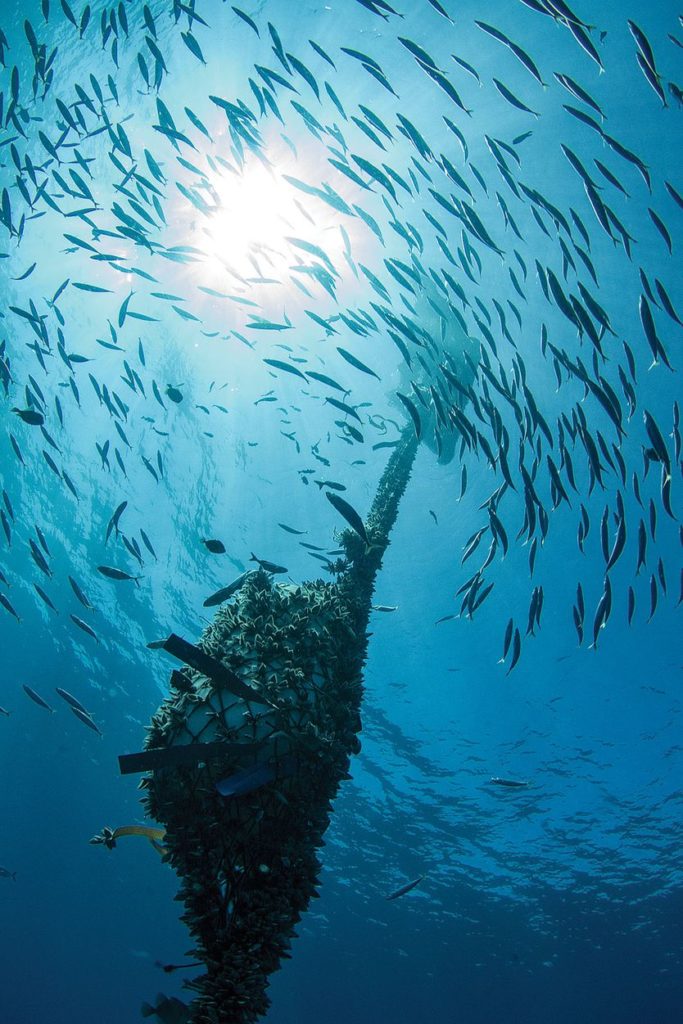
Fish-aggregating device in Costa Rica
Fishing FADs like this has become the hot ticket for billfish off Costa Rica in recent years.Adrian E. Gray
In 2013, FECOP showed the government that the country’s tuna resource was being given to foreign purse seine boats for as little as $37 a ton, and that the purse seiners also were affecting populations of pelagic species that attract tourists. When the purse seiners’ nets actually wrapped up some sport-fishing boats out of Los Sueños Marina as the seiners encircled a pod of spinner dolphins, it was the final straw. In 2014, a decree was signed moving the tuna boats out 45 miles from the coast to protect numerous seamounts, creating an area of 77,220 square miles where purse seiners could no longer operate. Their catch was limited to 9,000 metric tons a year, down from a onetime high of nearly 25,000 metric tons, and that catch had to be sold to the local cannery in Puntarenas. Moises Mug, a scientist for FECOP, analyzed observer onboard reports for the purse seine fleet in 2018 and discovered that moving the purse seiners farther out was saving 25 tons of marlin annually from ending up as seiners’ bycatch. During the past six or seven years, the recovery of various pelagic species off Costa Rica has been remarkable.
Then there’s the FAD issue. Critics of fish aggregating devices claim that they are akin to hunting in baited fields, putting too much pressure on the fish, and once commercial boats find the locations, they end up killing too many marlin. But more study is needed to really assess the situation. Toward that end, a Stanford University team led by Larry Crowder, Ph.D., made trips to Costa Rica every few months in 2019 to place satellite tags on marlin and sailfish. At the time of this writing, biologists Danielle Haulsee and Hanna Blondin had placed tags on 33 marlin and 14 sails. They tagged many of the marlin on FADs. The tags were set to pop off and transmit data at intervals of six, nine and 12 months. As they return data, scientists should have a clearer picture of how FADS are affecting these fish.
You May Also Like
Costa Rica Fishing – Guide to Having a Great Trip
Tourism Slated to Open Domestically in the Next Few Months
Costa Rica’s Laws and Regulations for Sport Fishing are Working
Learn More About Costa Rica Fishing Species
Subscribe to Our Newsletter
[yikes-mailchimp form=”1″]

